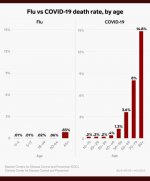Dans le tout dernier Situation Report du WHO:
"SUBJECT IN FOCUS: Q&A: Similarities and differences – COVID-19 and influenza
Q. How are COVID-19 and influenza viruses similar?
Firstly, COVID-19 and influenza viruses have a similar disease presentation. That is, they both cause respiratory disease, which presents as a wide range of illness from asymptomatic or mild through to severe disease and death. Secondly, both viruses are transmitted by contact, droplets and fomites. As a result, the same public health measures, such as hand hygiene and good respiratory etiquette (coughing into your elbow or into a tissue and immediately disposing of the tissue), are important actions all can take to prevent infection.
Q. How are COVID-19 and influenza viruses different?
The speed of transmission is an important point of difference between the two viruses. Influenza has a shorter median incubation period (the time from infection to appearance of symptoms) and a shorter serial interval (the time between successive cases) than COVID-19 virus. The serial interval for COVID-19 virus is estimated to be 5-6 days, while for influenza virus, the serial interval is 3 days. This means that influenza can spread faster than COVID19. Further, transmission in the first 3-5 days of illness, or potentially pre-symptomatic transmission –transmission of the virus before the appearance of symptoms – is a major driver of transmission for influenza. In contrast, while we are learning that there are people who can shed COVID-19 virus 24-48 hours prior to symptom onset, at present, this does not appear to be a major driver of transmission.
The reproductive number – the number of secondary infections generated from one infected individual – is understood to be between 2 and 2.5 for COVID-19 virus, higher than for influenza. However, estimates for both COVID-19 and influenza viruses are very context and time-specific, making direct comparisons more difficult.
Children are important drivers of influenza virus transmission in the community. For COVID-19 virus, initial data indicates that children are less affected than adults and that clinical attack rates in the 0-19 age group are low. Further preliminary data from household transmission studies in China suggest that children are infected from adults, rather than vice versa.
While the range of symptoms for the two viruses is similar, the fraction with severe disease appears to be different. For COVID-19, data to date suggest that 80% of infections are mild or asymptomatic, 15% are severe infection, requiring oxygen and 5% are critical infections, requiring ventilation. These fractions of severe and critical infection would be higher than what is observed for influenza infection. Those most at risk for severe influenza infection are children, pregnant women, elderly, those with underlying
chronic medical conditions and those who are immunosuppressed. For COVID-19, our current understanding is that older age and underlying conditions increase the risk for severe infection.
Mortality for COVID-19 appears higher than for influenza, especially seasonal influenza. While the true mortality of COVID-19 will take some time to fully understand, the data we have so far indicate that the crude mortality ratio (the number of reported deaths divided by the reported cases) is between 3-4%, the infection mortality rate (the number of reported deaths divided by the number of infections) will be lower. For seasonal influenza, mortality is usually well below 0.1%. However, mortality is to a large extent determined by access to and quality of health care.
Q. What medical interventions are available for COVID-19 and influenza viruses?
While there are a number of therapeutics currently in clinical trials in China and more than 20 vaccines in development for COVID-19, there are currently no licensed vaccines or therapeutics for COVID-19. In contrast, antivirals and vaccines available for influenza. While the influenza vaccine is not effective against COVID-19 virus, it is highly recommended to get vaccinated each year to prevent influenza infection. "



